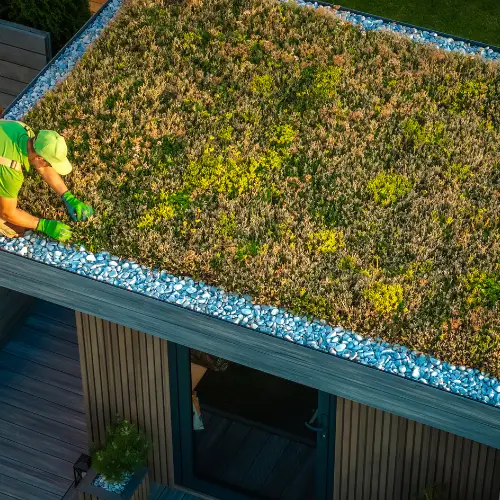
Flat roofs are a popular choice for both residential and commercial buildings, and they offer an excellent foundation for green roof installations. However, not all flat roofing materials are equally suitable for supporting a green roof. The right flat roofing material must be waterproof, durable, and strong enough to handle the extra weight of soil, plants, and water. In this guide, we’ll explore the best flat roofing materials for green roofs, along with installation tips and important considerations.
Why Flat Roofs Are Ideal for Green Roofs?
Flat roofs are often preferred for green roofs because of their horizontal surface, which allows for even water distribution, stable plant growth, and easier installation. Additionally, flat roofs reduce the need for complex drainage systems, making green roofs both practical and cost-effective.
Best Flat Roofing Materials for Green Roofs
When considering a flat roof for a green roof installation, you need to choose a roofing material that is waterproof, strong, and long-lasting. Here are the top flat roofing materials compatible with green roofs:
1. EPDM (Ethylene Propylene Diene Monomer)
EPDM roofing is a synthetic rubber material known for its waterproofing and flexibility. It’s a popular choice for commercial and residential flat roofs because of its ability to withstand extreme temperatures and weather conditions.
Why It Works for Green Roofs:
- Waterproof Surface: Prevents leaks and water seepage.
- Flexible and Durable: Expands and contracts with temperature changes.
- Root Resistance: Resistant to invasive roots when paired with a root barrier.
Installation Tip:
Apply a single-ply EPDM membrane before adding green roof layers. Make sure seams are sealed properly to avoid leaks.
2. TPO (Thermoplastic Polyolefin)
TPO roofing is another waterproof membrane made from rubber and plastic polymers. It’s commonly used in commercial flat roofs due to its energy efficiency and heat-reflective properties.
Why It Works for Green Roofs:
- Durability: Resistant to UV rays, heat, and punctures.
- Energy-Efficient: Reflects sunlight, reducing heat buildup under the roof.
- Eco-Friendly: Fully recyclable and environmentally safe.
Installation Tip:
Ensure a professional installation with heat-welded seams for maximum waterproofing. Use a root barrier to prevent plant roots from damaging the TPO layer.
3. PVC (Polyvinyl Chloride)
PVC roofing is a long-lasting plastic membrane known for its chemical resistance and waterproofing properties. It’s often used in commercial roofing projects due to its exceptional durability and weather resistance.
Why It Works for Green Roofs:
- Strong and Waterproof: Provides an impenetrable layer against water damage.
- Chemical-Resistant: Withstands fertilizers and plant-related chemicals.
- UV-Resistant: Reflects sunlight, reducing heat absorption.
Installation Tip:
Use a reinforced PVC membrane for heavy-duty green roofs. Ensure the edges are properly sealed to prevent water seepage.
4. Modified Bitumen
Modified bitumen roofing is an asphalt-based flat roofing material known for its durability and waterproofing capabilities. It comes in roll sheets and can be applied in layers for added protection.
Why It Works for Green Roofs:
- Strong and Durable: Withstands heavy loads and harsh weather.
- Multiple Layers: Can be reinforced with additional membranes.
- Affordable: Lower cost compared to some synthetic membranes.
Installation Tip:
Add a root barrier membrane on top of the modified bitumen layer to prevent plant roots from penetrating the roof.
- ades of weather exposure when maintained properly.
Installation Tip:
Ensure proper drainage by installing a drainage mat and gravel layer on top of the roof. Use a waterproof membrane underneath for added protection.
How to Prepare a Flat Roof for a Green Roof Installation
Installing a green roof on a flat roof requires careful preparation to ensure water management, structural integrity, and plant health. Follow these steps to get your flat roof ready:
Inspect the Roof:
Check for damage, leaks, or weak areas. Repair any issues before installation.Apply a Waterproof Membrane:
Use one of the recommended flat roofing materials like EPDM, TPO, or PVC to create a waterproof barrier.Add a Root Barrier:
Install a root barrier to prevent plant roots from penetrating the roof material.Install a Drainage Layer:
Use drainage mats or gravel to allow excess water to flow off the roof.Apply a Filter Fabric:
Place a filter fabric over the drainage layer to prevent soil from clogging the drainage system.Add the Growing Medium:
Use a lightweight, well-draining soil mix designed for green roofs.Plant the Green Roof:
Choose drought-tolerant plants like sedums, grasses, and herbs that can withstand changing weather conditions.
Why Choose Flat Roofing Materials for Green Roofs?
Flat roofing materials like EPDM, TPO, PVC and modified bitumen offer the durability, waterproofing, and strength needed to support a thriving green roof. When installed correctly, they provide long-lasting protection against water damage, leaks, and root invasion—ensuring your green roof remains healthy and functional for years to come.
- Choose waterproof, durable flat roofing materials like EPDM, TPO, PVC, or modified bitumen.
- Ensure proper installation with root barriers, drainage layers, and filter fabrics.
- Regularly inspect and maintain the roof for long-term performance.